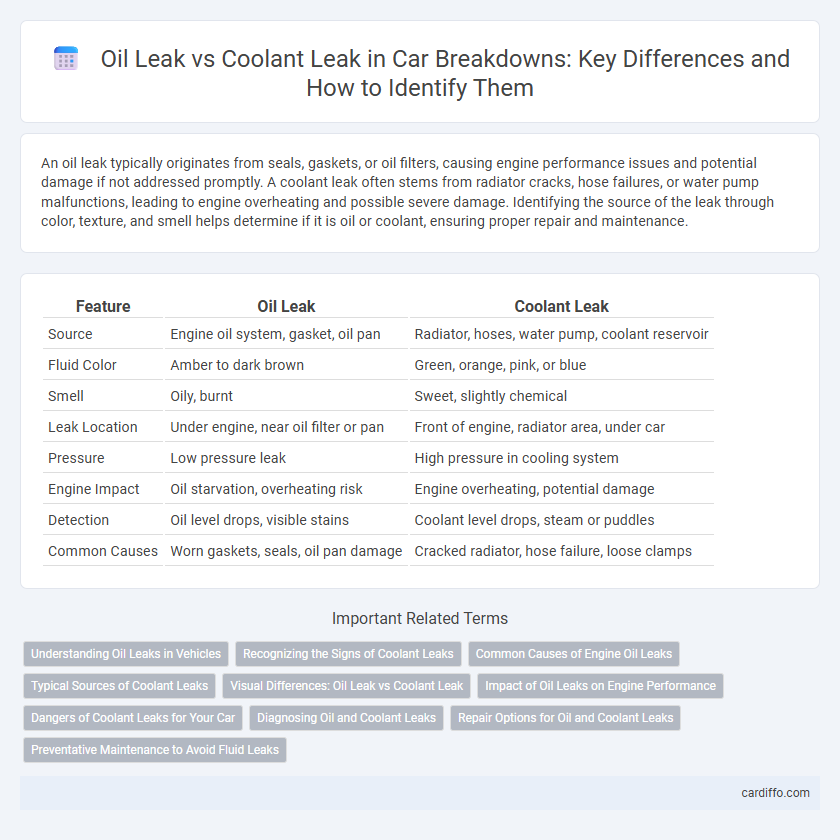An oil leak typically originates from seals, gaskets, or oil filters, causing engine performance issues and potential damage if not addressed promptly. A coolant leak often stems from radiator cracks, hose failures, or water pump malfunctions, leading to engine overheating and possible severe damage. Identifying the source of the leak through color, texture, and smell helps determine if it is oil or coolant, ensuring proper repair and maintenance.
Table of Comparison
| Feature | Oil Leak | Coolant Leak |
|---|---|---|
| Source | Engine oil system, gasket, oil pan | Radiator, hoses, water pump, coolant reservoir |
| Fluid Color | Amber to dark brown | Green, orange, pink, or blue |
| Smell | Oily, burnt | Sweet, slightly chemical |
| Leak Location | Under engine, near oil filter or pan | Front of engine, radiator area, under car |
| Pressure | Low pressure leak | High pressure in cooling system |
| Engine Impact | Oil starvation, overheating risk | Engine overheating, potential damage |
| Detection | Oil level drops, visible stains | Coolant level drops, steam or puddles |
| Common Causes | Worn gaskets, seals, oil pan damage | Cracked radiator, hose failure, loose clamps |
Understanding Oil Leaks in Vehicles
Oil leaks in vehicles often occur due to worn gaskets, seals, or damaged oil pans, leading to engine performance issues and potential damage if not addressed promptly. Identifying oil leaks involves checking for dark, viscous fluid on engine components or under the vehicle, which differs from the typically lighter, colored fluid of coolant leaks. Regular maintenance and timely repairs of oil leak sources can prevent engine overheating, reduced lubrication, and costly mechanical failures.
Recognizing the Signs of Coolant Leaks
Coolant leaks often manifest as puddles of bright green, orange, or pink fluid under the vehicle, accompanied by a sweet smell distinct from the petroleum odor of oil leaks. Engine overheating and low coolant levels serve as critical indicators of a coolant leak, contrasting with oil leaks which typically cause dark, slippery stains and decreased engine performance. Monitoring radiator and hose conditions can help identify early signs of coolant leaks before severe engine damage occurs.
Common Causes of Engine Oil Leaks
Engine oil leaks commonly result from worn-out gaskets, damaged seals, or loose drain plugs, often causing a visible pooling of oil beneath the vehicle. Faulty valve cover gaskets and oil pan gaskets frequently contribute to these leaks by allowing oil to escape under high pressure. Regular inspection of these components helps prevent engine damage and maintains optimal performance.
Typical Sources of Coolant Leaks
Typical sources of coolant leaks include damaged radiator hoses, a cracked radiator, a faulty water pump, and a compromised head gasket. Coolant leaks often originate from areas where the coolant circulates through the engine and cooling system, especially at hose connections and the radiator. Identifying the source quickly is crucial to prevent engine overheating and significant mechanical damage.
Visual Differences: Oil Leak vs Coolant Leak
Oil leaks typically appear as dark brown or black stains with a slick, greasy texture, often found under the engine or near oil seals. Coolant leaks usually present as bright green, orange, or pink fluid with a thinner, watery consistency and may leave crystalline deposits when dried around the radiator or hoses. Visual inspection of the leak's color, texture, and location helps differentiate between an oil leak and a coolant leak effectively.
Impact of Oil Leaks on Engine Performance
Oil leaks reduce engine lubrication, causing increased friction and overheating that lead to premature engine wear and potential failure. Contaminated oil from leaks compromises combustion efficiency, resulting in reduced power and higher fuel consumption. Persistent oil leaks can damage critical engine components, necessitating costly repairs and risking total engine breakdown.
Dangers of Coolant Leaks for Your Car
Coolant leaks pose significant dangers to your car, including engine overheating and potential head gasket failure, leading to costly repairs. Unlike oil leaks, coolant leaks can cause the engine to run hot, damaging critical components and compromising vehicle safety. Detecting and addressing coolant leaks promptly helps maintain optimal engine temperature and prevents severe mechanical breakdowns.
Diagnosing Oil and Coolant Leaks
Diagnosing oil and coolant leaks requires identifying the origin and type of fluid by inspecting engine components such as valve covers, oil pan gaskets, radiator hoses, and water pumps. Oil leaks typically present as dark, viscous stains with a distinct petroleum smell, often found near the engine or oil filter, while coolant leaks are usually bright green, orange, or pink fluids with a sweet odor, often pooling around the radiator, hoses, or heater core. Using UV dye testing and pressure testing can pinpoint leaks accurately, preventing engine overheating and maintaining proper lubrication.
Repair Options for Oil and Coolant Leaks
Repair options for oil leaks include replacing gaskets or seals, tightening loose components, and using stop-leak additives for minor issues, while severe leaks may require professional inspection or engine part replacement. Coolant leak repairs often involve replacing damaged hoses, radiator repairs or flushes, and tightening or replacing the thermostat housing; in some cases, sealing leaks with specialized coolant sealants is effective. Both types of leaks demand prompt attention to prevent engine damage and maintain optimal vehicle performance.
Preventative Maintenance to Avoid Fluid Leaks
Regularly inspecting seals, hoses, and gaskets during preventative maintenance can significantly reduce the risk of oil and coolant leaks, preserving engine performance and preventing costly repairs. Using manufacturer-recommended fluids and maintaining proper fluid levels ensure system integrity and prevent degradation that leads to leaks. Early detection through routine checks helps address minor leaks before they develop into major breakdowns, safeguarding vehicle reliability.
Oil leak vs coolant leak Infographic

 cardiffo.com
cardiffo.com